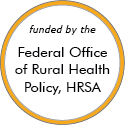Rural Schools and Health – Models and Innovations
These stories feature model programs and successful rural projects that can serve as a source of ideas and provide lessons others have learned. Some of the projects or programs may no longer be active. Read about the criteria and evidence-base for programs included.
Evidence-Based Examples
PROSPER Partnerships
Updated/reviewed June 2025
- Need: An approach to support sustained, quality delivery of evidence-based programs for youth and families in rural communities.
- Intervention: PROSPER, a program delivery system, guides communities in implementing evidence-based programs that build youth competencies, improve family functioning, and prevent risky behaviors, particularly substance use.
- Results: Youth in PROSPER communities reported delayed initiation of a variety of substances, lower levels of other behavioral problems, and improvements in family functioning and other life skills.
Promising Examples
Healthy Early Learning Project (HELP)

Updated/reviewed September 2025
- Need: An ongoing health need to alleviate early childhood obesity in the rural Kansas counties of Marshall and Nemaha.
- Intervention: 5 distinct physical and nutritional programs were introduced to 9 preschool sites through the overarching Healthy Early Learning Project (HELP).
- Results: HELP comprehensively increased children's physical activity and healthy food consumption and established a sustainable presence at each preschool site.
Schools That Care

Updated/reviewed September 2025
- Need: To provide mental health services to rural Kansas students and their families.
- Intervention: The Schools That Care project provides mental health treatment and case management as well as community education events.
- Results: From 2018 to 2021, 3,456 individuals participated in health education and counseling activities offered to the public, and 964 individuals and 303 families received direct services through the Family Advocate.
School-Based Health Center Dental Outreach

Updated/reviewed July 2020
- Need: To improve the oral health status of children ages 3 to 17 living in rural areas of Louisiana.
- Intervention: School-based nurse practitioners perform oral health assessments, apply fluoride varnishes when indicated, and make dental referrals, with completion rates of the latter tracked by dental case managers.
- Results: Significant numbers of school children are receiving oral health examinations, fluoride varnish applications, and receiving care coordination to improve numbers of completed dental appointments.
Other Project Examples
Club Scrub
Updated/reviewed December 2025
- Need: Impact healthcare workforce shortages in rural Wisconsin.
- Intervention: The Rural Wisconsin Health Cooperative, leveraging evidence-informed grow-your-own pipeline activities to generate interest in health-related professions, partnered with the Wisconsin Office of Rural Health to create the Club Scrub program for 7th and 8th graders.
- Results: The original 2006-2007 program results revealed that participants gained a better understanding of career options in the healthcare industry and annual Club Scrub events continue to be sponsored by several Wisconsin rural healthcare delivery systems.
Schools as a Hub for Health
Updated/reviewed September 2025
- Need: To improve health outcomes in rural Appalachian Ohio.
- Intervention: Schools as a Hub for Health promoted holistic wellness for the whole community by creating or bringing in programs that support physical, mental, and social health.
- Results: The project gained administrator buy-in and facilitated the development of a variety of health-focused school-based programs.
Hope Squad
Updated/reviewed June 2025
- Need: To reduce youth suicide rates.
- Intervention: First begun in Utah, Hope Squad is a nationwide program that trains youth to identify peers' signs of distress and connect them to help. Hope Squads educate the entire student body to increase connectedness and reduce stigma.
- Results: Studies suggest that Hope Squad schools' students with suicidal thoughts are more likely than non-Hope Squad schools' students to solicit help. In addition, stigma surrounding mental illness is decreasing.
It's a Girl Thing: Making Proud Choices
Updated/reviewed June 2025
- Need: Teen pregnancy, sexually transmitted diseases, and mental health challenges in adolescent girls were concerns for members of Union Parish, Louisiana.
- Intervention: Union General Hospital, a Critical Access Hospital, created the program It's a Girl Thing: Making Proud Choices to teach prevention, self-confidence, personal responsibility, and mental well-being to teen girls.
- Results: Teen pregnancy rates in Union Parish have dropped by more than 40% since the start of the program, significantly exceeding the program's initial goal of 5%. Graduation rates have also increased. The addition of Together We Can Be Bully Free as an integral part of It's a Girl Thing has further expanded mental health support for participants.
Together We Can Be Bully Free
Updated/reviewed June 2025
- Need: Union Parish, a rural county in Louisiana, continues to experience elevated rates of youth suicide, bullying, mental health challenges, and risk behaviors, as confirmed by a 2024 Community Health Needs Assessment (CHNA).
- Intervention: Union General Hospital, a Critical Access Hospital, started a program to educate students grade 4 through 12 on the negative effects of bullying, to foster positive social behavior, and to provide mental health support through school-based interventions.
- Results: Over 3,500 students have learned how to recognize, report, and respond to bullying. The program's integration with broader community health priorities has strengthened mental health, reduced suicide attempts, and improved awareness of youth risk behaviors.
Project ACTIVATE (Advancing Coordinated and Timely InterVentions, Awareness, Training, and Education)
Updated/reviewed May 2025
- Need: To improve students' access to behavioral health services in rural North Carolina.
- Intervention: North Carolina Project ACTIVATE provides three tiers of behavioral health supports in the school setting.
- Results: The six pilot sites (Cohorts 1 and 2) have created or revised 91 mental health policies, and 48,531 school-based and related employees have received training in different topics and protocols.
Last Reviewed: 4/22/2025

